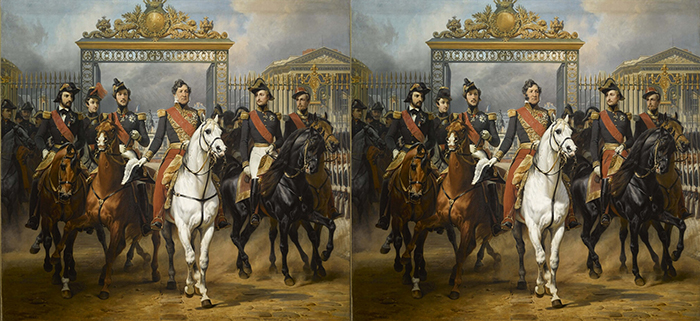Can you spot the differences hidden in these famous paintings?
Spot the difference game
Marie-Antoinette
In the painting Marie-Antoinette, Queen of France (1755-1793)

At the 1783 Salon, Elisabeth Vigée Le Brun unveiled a new portrait of the queen, which shocked the attendees, as the subject was wearing a light muslin dress. The artist quickly produced a second portrait to be exhibited at the Salon before it ended. This time, she clothed the queen in a traditional dress of blue-grey silk, indicating Marie-Antoinette’s implied support for Lyon silk. Several replicas were made of the painting, including this one held by the Palace of Versailles.
Now, it’s your turn! Can you spot the 7 differences that have been introduced to the painting on the right, above?
Enlarge the painting Check out the answers
Napoleon I
In the painting "Bonaparte crossing the Alps, 20 May 1800"

Napoleon Bonaparte came from a minor Corsican noble family and fulfilled an extraordinary destiny by becoming Emperor of the French in May 1804. A great military leader, he is renowned for his many conquests. During his second Italian campaign, he had himself portrayed crossing the Alps at the Saint-Bernard Pass by the painter David. Five versions of this equestrian portrait were produced: one for the king of Spain, three for Napoleon himself, and one retained by the artist. Although quite similar, the paintings feature minor differences, which make each one unique. Two of them are now part of the Palace of Versailles collections.
Look closely at the portraits above: on the left is one of the originals held by the Palace, while, on the right is the same portrait but with 7 differences. Can you spot them?
Enlarge the paintings Check out the answers
Louis-Philippe
In the painting "King Louis-Philippe surrounded by his five sons exiting via the Honour Gate at the Palace of Versailles after passing a military review in the courtyards, 10 June 1837"

The king is portrayed with his sons, all on horseback as they mill around in front of the gates of the Palace of Versailles, behind which, on the right, is the Gabriel Pavilion bearing the dedication of this historical museum “To all the glories of France”. In the background, the equestrian statue of Louis XIV by Cartellier and Petitot, which was installed on the order of Louis-Philippe (and recently moved), commemorates the Versailles founder and ancestor of the princes in the painting. The work illustrates the king’s great interest in his Versailles museum and the operation to revive one of the most iconic seats of power in French national history.
Enlarge the paintings Check out the answers
Louis XIV
In the painting "Louis XIV, protector of the arts and sciences"

This likeness of Louis XIV is an homage to the great patron and protector of the arts and sciences – sources of such great wealth for his kingdom. The king is portrayed here as a warrior, wearing a breastplate adorned with fleurs-de-lis and surrounded by the arts – represented by various musical instruments (double bass, violin, guitar, bagpipes, etc.) – and the plan of the Maison Carrée Roman temple in Nîmes. His role as protector of the sciences, meanwhile, is illustrated by the celestial globe, on which the constellations of the zodiac can be seen, the scholarly books and the various scientific instruments.




